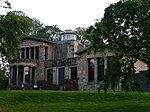Netherlee

Netherlee is a suburban residential area in East Renfrewshire, Scotland. It is situated on the west bank of the White Cart Water about 4 miles (6.5 km) south of Glasgow city centre. Part of the Greater Glasgow conurbation, it is mostly contiguous with the city, and is just beyond the boundary of its local authority area. It is a separate census locality from Glasgow, like other areas such as neighbouring Giffnock and Clarkston. Netherlee is directly contiguous with Stamperland. It is also in a council ward with Clarkston and its neighbour Busby. As of 2012, Netherlee has a population of 4,550. Originally a small rural hamlet dependent upon the mills along the river, Netherlee became extensively urbanised in the 20th century, developing into an affluent commuter suburb. The area is served by a parish church, primary school and library, as well as a number of local shops and parks. Cathcart Cemetery also falls within the boundaries of Netherlee.
Excerpt from the Wikipedia article Netherlee (License: CC BY-SA 3.0, Authors, Images).Netherlee
Clarkston Road,
Geographical coordinates (GPS) Address Phone number Nearby Places Show on map
Geographical coordinates (GPS)
| Latitude | Longitude |
|---|---|
| N 55.802 ° | E -4.27 ° |
Address
Netherlee Primary School
Clarkston Road
G44 3SF , Netherlee
Scotland, United Kingdom
Open on Google Maps








